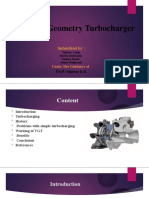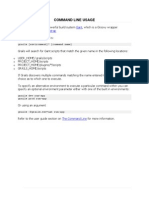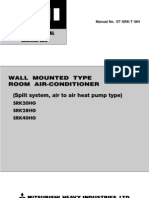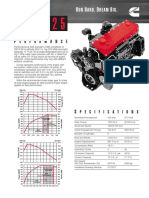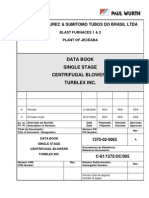Introduction To Automobile Engineering
Introduction To Automobile Engineering
Uploaded by
Saurabh AwacharOriginal Description:
Original Title
Copyright
Available Formats
Share this document
Did you find this document useful?
Is this content inappropriate?
Report this DocumentCopyright:
Available Formats
Introduction To Automobile Engineering
Introduction To Automobile Engineering
Uploaded by
Saurabh AwacharCopyright:
Available Formats
Marathwada Mitra Mandala’s Polytechnic MAKE THE MODEL OF PISTON VI HELP OF WOOD
1. INTRODUCTION
1.1. Pistons
A piston is a component of reciprocating engines, reciprocating pumps, gas
compressors and pneumatic cylinders, among other similar mechanisms. It is the moving
component that is contained by a cylinder and is made gas-tight by piston rings. In an engine,
its purpose is to transfer force from expanding gas in the cylinder to the crankshaft via a
piston rod and/or connecting rod. In a pump, the function is reversed and force is transferred
from the crankshaft to the piston for the purpose of compressing or ejecting the fluid in the
cylinder. In some engines, the piston also acts as a valve by covering and uncovering ports in
the cylinder.
An internal combustion engine is acted upon by the pressure of the expanding
combustion gases in the combustion chamber space at the top of the cylinder. This force then
acts downwards through the connecting rod and onto the crankshaft. The connecting rod is
attached to the piston by a swiveling gudgeon pin (US: wrist pin). This pin is mounted within
the piston: unlike the steam engine, there is no piston rod or crosshead (except big two stroke
engines).
1.2.Type of pistons
The typical piston design is on the picture. This type of piston is widely used in
car diesel engines. According to purpose, supercharging level and working conditions of
engines the shape and proportions can be changed.
Fig.no.1(simple piston structure)
Pistons are cast from aluminum alloys. For better strength and fatigue life,
some racing pistons may be forged instead. Billet pistons are also used in racing engines
because they do not rely on the size and architecture of available forgings, allowing for last-
minute design changes.
1 AEN Micro Project
Marathwada Mitra Mandala’s Polytechnic MAKE THE MODEL OF PISTON VI HELP OF WOOD
Although not commonly visible to the naked eye, pistons themselves are designed
with a certain level of opacity and profile taper, meaning they are not perfectly round,
and their diameter is larger near the bottom of the skirt than at the crown.
1.2.1. Trunk pistons
Trunk pistons are long relative to their diameter. They act both as a piston and
cylindrical crosshead. As the connecting rod is angled for much of its rotation, there is also a
side force that reacts along the side of the piston against the cylinder wall. A longer piston
helps to support this.
A characteristic of most trunk pistons, particularly for diesel engines, is that they have
a groove for an oil ring below the gudgeon pin, in addition to the rings between the gudgeon
pin and crown.
Below figure shows the trunk piston
Fig.no.2 (trunk piston)
Trunk pistons have been a common design of piston since the early days of the
reciprocating internal combustion engine. They were used for both petrol and diesel engines,
although high speed engines have now adopted the lighter weight slipper piston. The name
'trunk piston' derives from the 'trunk engine', an early design of marine steam engine.
To make these more compact, they avoided the steam engine's usual piston rod with
separate crosshead and were instead the first engine design to place the gudgeon pin directly
within the piston. Otherwise these trunk engine pistons bore little resemblance to the trunk
piston; they were extremely large diameter and double-acting. Their 'trunk' was a narrow
cylinder mounted in the center of the piston.
2 AEN Micro Project
Marathwada Mitra Mandala’s Polytechnic MAKE THE MODEL OF PISTON VI HELP OF WOOD
1.2.2. Crosshead pistons
Large slow-speed Diesel engines may require additional support for the side forces on the
piston. These engines typically use crosshead pistons. The main piston has a large piston rod
extending downwards from the piston to what is effectively a second smaller-diameter piston.
The main piston is responsible for gas sealing and carries the piston rings. The smaller
piston is purely a mechanical guide. It runs within a small cylinder as a trunk guide and also
carries the gudgeon pin.
Below figure shows the crosshead piston
Fig.no.3 (crosshead piston)
Lubrication of the crosshead has advantages over the trunk piston as its lubricating oil
is not subject to the heat of combustion: The oil is not contaminated by combustion soot
particles It does not break down owing to the heat and a thinner less viscous oil may be used.
The friction of both piston and crosshead may be only half of that for a trunk piston. Because
of the additional weight of these pistons, they are not used full
1.2.3. Slipper pistons
A slipper piston is a piston for a petrol engine that has been reduced in size and weight as
much as possible.
In the extreme case, they are reduced to the piston crown, support for the piston rings,
and just enough of the piston skirt remaining to leave two lands so as to stop the piston
rocking in the bore.The sides of the piston skirt around the gudgeon pin are reduced away
from the cylinder wall. The purpose is mostly to reduce the reciprocating mass, thus making
it easier to balance the engine and so permit high speeds.
Bellows figure shows slipper piston
3 AEN Micro Project
Marathwada Mitra Mandala’s Polytechnic MAKE THE MODEL OF PISTON VI HELP OF WOOD
Fig.no.4 (slipper piston)
In racing applications,
Slipper piston skirts can be configured to yield extremely light weight while maintaining the
rigidity and strength of a full skirt.
Reduced inertia also improves mechanical efficiency of the engine: the forces
required to accelerate and decelerate the reciprocating parts cause more piston friction with
the cylinder wall than the fluid pressure on the piston head.
A secondary benefit may be some reduction in friction with the cylinder wall, since
the area of the skirt, which slides up and down in the cylinder is reduced by half. However,
most friction is due to the piston rings, which are the parts which actually fit the tightest in
the bore and the bearing surfaces of the wrist pin, and thus the benefit is reduced.
1.2.4. Deflector pistons
Deflector pistons are used in two-stroke engines with crankcase compression, where the
gas flow within the cylinder must be carefully directed in order to provide efficient
scavenging. With cross scavenging, the transfer (inlet to the cylinder) and exhaust ports are
on directly facing sides of the cylinder wall.
To prevent the incoming mixture passing straight across from one port to the other, the
piston has a raised rib on its crown. This is intended to deflect the incoming mixture upwards,
around the combustion chamber.
Below figure shows deflection piston
4 AEN Micro Project
Marathwada Mitra Mandala’s Polytechnic MAKE THE MODEL OF PISTON VI HELP OF WOOD
Fig.no.5 (deflection piston)
Much effort, and many different designs of piston crown, went into developing improved
scavenging.
The crowns developed from a simple rib to a large asymmetric bulge, usually with a
steep face on the inlet side and a gentle curve on the exhaust. Despite this, cross scavenging
was never as effective as hoped. Most engines today use Schnuerle porting instead.
This places a pair of transfer ports in the sides of the cylinder and encourages gas flow to
rotate around a v vertical axis, rather than a horizontal axis.
1.3 Pistons features
Piston head,
Piston pin bore,
Piston pin,
Skirt,
Ring grooves,
Ring lands, and
Piston rings
5 AEN Micro Project
Marathwada Mitra Mandala’s Polytechnic MAKE THE MODEL OF PISTON VI HELP OF WOOD
Fig.no.6 (piston structure with naming)
The piston head is the top surface (closest to the cylinder head) of the piston which is
subjected to tremendous forces and heat during normal engine operation.
A piston pin bore is a through hole in the side of the piston perpendicular to piston travel
that receives the piston pin.
A piston pin is a hollow shaft that connects the small end of the connecting rod to the piston.
The skirt of a piston is the portion of the piston closest to the crankshaft that helps align the
piston as it moves in the cylinder bore.
A ring groove is a recessed area located around the perimeter of the piston that is used to
retain a piston ring.
Ring lands are the two parallel surfaces of the ring groove which function as the sealing
surface for the piston ring.
A piston ring is an expandable split ring used to provide a seal between the piston an the
cylinder wall.
1.4. Pistons design considerations
1.4.1. Pistons must:
Contain cylinder pressure
Transmit the pressure created by combustion to force on the connecting rod Provide a
place for oil control and compression rings to be located Aluminium expands when heated,
and Proper clearance must be provided to maintain free piston movement in the cylinder
bore.
Insufficient clearance can cause the piston to seize in the cylinder. Excessive
clearance can cause a loss of compression and an increase in piston noise Be rigid enough to
not deform under the tremendous pressures and forces encountered Be ductile enough to
absorb pressure peaks and not shatter Retain the proper shape under the extreme
temperatures encountered.
6 AEN Micro Project
Marathwada Mitra Mandala’s Polytechnic MAKE THE MODEL OF PISTON VI HELP OF WOOD
Fig.no.7 (simple piston with naming)
1.4.2. Pistons construction
Piston head=
Round
Approx. . . .040 underside
Ring grooves
Ring lands
Drain holes and sol
Wrist pin boss
Reinforcing struts – cast pistons contain steel struts to control expansion and aid in wrist
pin support
Lock ring grooves – for full-floating piston pins
Piston skirt
Full skirt
Partial skirt
1.5. FUNCTION OF PISTON
A piston is a component of reciprocating engines, reciprocating pumps, gas
compressors and pneumatic cylinders, among other similar mechanisms.
It is the moving component that is contained by a cylinder and is made gas-tight by
piston rings. In an engine, its purpose is to transfer force from expanding gas in the
cylinder to the crankshaft via a piston rod and/or connecting rod. In a pump, the
function is reversed and force is transferred from the crankshaft to the piston for the
purpose of compressing or ejecting the fluid in the cylinder.
7 AEN Micro Project
Marathwada Mitra Mandala’s Polytechnic MAKE THE MODEL OF PISTON VI HELP OF WOOD
In some engines, the piston also acts as a valve by covering and uncovering ports in
the cylinder
1.6. APPLICTION OF PISTON
Reduced inertia also improves the mechanical efficiency of the engine.
It compresses the fluid inside the cylinder hence increases the pressure and
temperature of the fluid inside the cylinder.
It also provides the direction.
1.7. ADVANTAGES OF PISTON
mechanical simplicity
flexibility and reliability
power to weight ratio
multi-fuel capability
low turbine operating temperature
less vibration and noise
less maintenance
easy to start piston
highly suitable for waste heat recovery
give a high degree of manoeuvrability
less manufacturing cost
low Knox emissions
it offers hcci combustion process
internally balanced
modularity
1.8. DISADVANTAGES OF PISTON
Taper Pistons
Cam ground Pistons
Special alloys pistons
Wire wound pistons
Auto thermic pistons
Bimetal pistons
Cast steel piston
Tinned pistons
Oil cooled pistons
Two-piece pistons
1.9. CONCLUSION
We studied the piston and its or
8 AEN Micro Project
You might also like
- Engine Components and OperationDocument24 pagesEngine Components and OperationAndrew CrawfordNo ratings yet
- Class 4 Transient Operational Effects On PollutionDocument37 pagesClass 4 Transient Operational Effects On PollutionBharathiraja Moorthy0% (1)
- Automobile Self StarterDocument2 pagesAutomobile Self StarterawadheshwetaNo ratings yet
- LV06 - Engines - Issue 1Document72 pagesLV06 - Engines - Issue 1Valentin Silvan Valentin SilvanNo ratings yet
- M Line Contactors & Relay PDFDocument8 pagesM Line Contactors & Relay PDFRemo GagalNo ratings yet
- Types of Internal Combustion EnginesDocument18 pagesTypes of Internal Combustion EnginesMoayadNo ratings yet
- Main Parts of An Internal Combustion EngineDocument9 pagesMain Parts of An Internal Combustion EngineVenkatNo ratings yet
- Engine Exhaust System Presentation by 14ME37Document14 pagesEngine Exhaust System Presentation by 14ME37Akash KumarNo ratings yet
- Cylinder Head & Valve Mechanism Inspection & ServiceDocument19 pagesCylinder Head & Valve Mechanism Inspection & ServiceGetachew Tikue100% (1)
- Fuel PumpDocument9 pagesFuel Pumpstevenotienoodhiambo141100% (1)
- 1 4 3 ClutchDocument10 pages1 4 3 ClutchShambhuNath VermaNo ratings yet
- Working Principle of ShaperDocument9 pagesWorking Principle of ShaperSamir BoseNo ratings yet
- Catalytic ConverterDocument11 pagesCatalytic ConverterAJ MukunNo ratings yet
- Lesson 2.1 Overview of I.C.E.Document8 pagesLesson 2.1 Overview of I.C.E.Andrew MerafuentesNo ratings yet
- Engine EmissionsDocument31 pagesEngine EmissionsAsad KhanNo ratings yet
- Classification of Engines & Its ComponentsDocument33 pagesClassification of Engines & Its ComponentsSunil DhankharNo ratings yet
- Injector Pumps In-Line Injection Pumps: Scroll-Metering SystemsDocument10 pagesInjector Pumps In-Line Injection Pumps: Scroll-Metering SystemsCate Sitati100% (1)
- Lab Manual: Department of Mechanical EngineeringDocument46 pagesLab Manual: Department of Mechanical EngineeringsrknotesNo ratings yet
- Introduction To ElectricityDocument15 pagesIntroduction To ElectricityCLester MadShadowNo ratings yet
- CHAPTER 2 CrankshaftDocument19 pagesCHAPTER 2 CrankshaftAUNG0% (1)
- 4-Stroke Final ReportDocument13 pages4-Stroke Final ReportVimal YadavNo ratings yet
- (906,103) Lubricating SystemDocument19 pages(906,103) Lubricating SystemAnmol JaiswalNo ratings yet
- Arduino Based Automatic Car Washing SystemDocument3 pagesArduino Based Automatic Car Washing SystemEditor IJTSRDNo ratings yet
- The Tilt CylindersDocument11 pagesThe Tilt CylindersweldsaidiNo ratings yet
- Use of CRDi MPFi Technology in AutomobilesDocument3 pagesUse of CRDi MPFi Technology in AutomobilesSreehari MNo ratings yet
- HBEFA41 Report TUG 09092019 PDFDocument138 pagesHBEFA41 Report TUG 09092019 PDFLuís CastroNo ratings yet
- 1 Defence University, College of EngineeringDocument41 pages1 Defence University, College of EngineeringGetachew TikueNo ratings yet
- A Presentation On Steering System & Geometry: by Sourabh JoshiDocument13 pagesA Presentation On Steering System & Geometry: by Sourabh JoshiAnkit Omar100% (1)
- Four-Stroke Engine Basics: Instructor: Adam MegelDocument47 pagesFour-Stroke Engine Basics: Instructor: Adam MegelJomel Solibio MarginNo ratings yet
- Turbocharging of Ic EnginesDocument5 pagesTurbocharging of Ic EnginesKrishna MurthyNo ratings yet
- Ic EngineDocument23 pagesIc EngineGanesh kumar100% (1)
- CYLINDER FINS Final ProjectDocument84 pagesCYLINDER FINS Final ProjectUttam Animireddy100% (1)
- Engine Components - NotesDocument210 pagesEngine Components - NotesArun SebuzNo ratings yet
- Reciprocating Engine Parts Design: G.T.U. B.E. (Mech) Sem-Viii 2011-12Document61 pagesReciprocating Engine Parts Design: G.T.U. B.E. (Mech) Sem-Viii 2011-12Divyraj JadejaNo ratings yet
- Qip Ice 12 Fuel Injection SystemsDocument40 pagesQip Ice 12 Fuel Injection SystemsAnonymous eyxVFR100% (1)
- Scavenging Detanation IgnitionDocument18 pagesScavenging Detanation IgnitionSajjad Hossain ShuvoNo ratings yet
- Ic EngineDocument11 pagesIc EngineKUMARESAN G BITNo ratings yet
- Vidya Vardhaka College of Engineering Mysuru: "Diesel Particulate Filter"Document15 pagesVidya Vardhaka College of Engineering Mysuru: "Diesel Particulate Filter"dhanalakshmi k sNo ratings yet
- Automobile Engines PDFDocument3 pagesAutomobile Engines PDFPrashant GautamNo ratings yet
- Crdi System PDFDocument20 pagesCrdi System PDFsanath santhoshNo ratings yet
- Retarder Auxiliary Brake Systems ExplainedDocument10 pagesRetarder Auxiliary Brake Systems ExplainedWaleed BahnasyNo ratings yet
- Ic Engines Fuel RatingDocument74 pagesIc Engines Fuel RatingKodanda RamaraoNo ratings yet
- UNIT-8 Bearing Materials: SyllabusDocument8 pagesUNIT-8 Bearing Materials: SyllabusDebanjan SenNo ratings yet
- 1.conventional SteeringDocument11 pages1.conventional SteeringRaghu Ram Bura100% (1)
- Emission Control SystemDocument26 pagesEmission Control SystemnahomNo ratings yet
- Lecture - 12 - Engine Lubrication Systems - 28.3.2022Document31 pagesLecture - 12 - Engine Lubrication Systems - 28.3.2022VidhiNo ratings yet
- Lancashire BoilerDocument12 pagesLancashire BoilerSNEH PODDARNo ratings yet
- MM323 Assignment 2 Report Format - NewDocument21 pagesMM323 Assignment 2 Report Format - NewKelemedi DreuNo ratings yet
- Ic Engines: Four Stroke Cycle Diesel EnginesDocument11 pagesIc Engines: Four Stroke Cycle Diesel Enginesmechjobs4meNo ratings yet
- Performance Evaluation of Alaoji Thermal Power PlantDocument8 pagesPerformance Evaluation of Alaoji Thermal Power PlantIjaems JournalNo ratings yet
- Fuel Supply System: Unit 1 BDocument23 pagesFuel Supply System: Unit 1 BAnubhav SinghNo ratings yet
- Automotive (2) Lab: Suspension SystemDocument8 pagesAutomotive (2) Lab: Suspension SystemMohammad YahyaNo ratings yet
- Thermal Engineering-2 PracticalDocument35 pagesThermal Engineering-2 PracticalAlok Anand100% (1)
- On Variable Geometry TurbochargerDocument10 pagesOn Variable Geometry TurbochargerVaibhav Ghule100% (1)
- Fuel Supply System System in S.I EngineDocument47 pagesFuel Supply System System in S.I EngineSanjay HedgeNo ratings yet
- Chapter 8 - Electrical, Starting, and Ignition SystemsDocument213 pagesChapter 8 - Electrical, Starting, and Ignition SystemsKim RioverosNo ratings yet
- Lecture - 2: I. C. Engines Working Principles of I.C. Engines Study of Different Components of I.C. EnginesDocument29 pagesLecture - 2: I. C. Engines Working Principles of I.C. Engines Study of Different Components of I.C. EnginesViknesh WaranNo ratings yet
- Emission TestsDocument30 pagesEmission TestsBoobalakrishnan A R MoorthyNo ratings yet
- Piston - WikipediaDocument30 pagesPiston - WikipediaLAliNo ratings yet
- 4 ReportDocument89 pages4 ReportRajesh KesapragadaNo ratings yet
- Grails Command MainDocument294 pagesGrails Command Mainnik_coolNo ratings yet
- FAQ - Which Standards Stipulate Delay Time Before Inspecting WeldsDocument3 pagesFAQ - Which Standards Stipulate Delay Time Before Inspecting WeldsJessica JacksonNo ratings yet
- Physics Lab VIVA VOICEDocument5 pagesPhysics Lab VIVA VOICENoble Sharma75% (4)
- PG Certification in Data Science & AI Hyd - EdvancerDocument14 pagesPG Certification in Data Science & AI Hyd - Edvancerdwaraka mayeeNo ratings yet
- Prediction of Drying Time of Expanded Eps BlocksDocument126 pagesPrediction of Drying Time of Expanded Eps BlocksQuimicosgenericosgaffaro GaffaroNo ratings yet
- Ies: Electronics & Telecommunication Engineering Paper - I: 1. Materials and ComponentsDocument5 pagesIes: Electronics & Telecommunication Engineering Paper - I: 1. Materials and ComponentsrkbazadNo ratings yet
- 6 8051 IO InterfacingDocument66 pages6 8051 IO InterfacingSahilYadavNo ratings yet
- Boostrap StatisticDocument13 pagesBoostrap StatisticGerman GaldamezNo ratings yet
- Final SSCE1693 20162017Document8 pagesFinal SSCE1693 20162017elaNo ratings yet
- Service Manual SRK - HGDocument39 pagesService Manual SRK - HGАнастасия ДоморацкаяNo ratings yet
- Naïve Bayes Algorithm For Classification of Student Major's SpecializationDocument5 pagesNaïve Bayes Algorithm For Classification of Student Major's SpecializationSausan Hidayah NovaNo ratings yet
- C Programming Lecture Notes 2008-09Document173 pagesC Programming Lecture Notes 2008-09mm010aNo ratings yet
- Couchbase SDK Net 1.2 PDFDocument57 pagesCouchbase SDK Net 1.2 PDFEdward KokNo ratings yet
- ANS: (2.59807m/s2 Horizontal) (1.5m/s2 Vertical) (12.93725 Degree Angle That The Water Surface Makes With The Horizontal)Document5 pagesANS: (2.59807m/s2 Horizontal) (1.5m/s2 Vertical) (12.93725 Degree Angle That The Water Surface Makes With The Horizontal)Lolly UmaliNo ratings yet
- Pavement Materials: Highway and Transportation Engineering (Faculty of Engineering)Document38 pagesPavement Materials: Highway and Transportation Engineering (Faculty of Engineering)atharNo ratings yet
- Comp - Roll Crusher & SizerDocument2 pagesComp - Roll Crusher & Sizerrajeevup2004100% (1)
- Cummins ISM 11 425hp Engine Spec SheetDocument2 pagesCummins ISM 11 425hp Engine Spec SheetFranklin Boada0% (1)
- S7 Service 2 Course (ST-SERV2) : Short DescriptionDocument2 pagesS7 Service 2 Course (ST-SERV2) : Short DescriptionIndustrial ItNo ratings yet
- PiC900 HardwareManual en-US Rev13Document508 pagesPiC900 HardwareManual en-US Rev13Ramon MariscalNo ratings yet
- EE2-Malic Acid Vs Citric - For WebDocument21 pagesEE2-Malic Acid Vs Citric - For WebAnnerlynn SolanoNo ratings yet
- Pore Pressure-Engineering GeologyDocument26 pagesPore Pressure-Engineering GeologyChiranjaya HulangamuwaNo ratings yet
- Specifications - FX 1502 - 7223Document4 pagesSpecifications - FX 1502 - 7223ridNo ratings yet
- Introduction To Thermography Basic: R. Sajith CecilDocument43 pagesIntroduction To Thermography Basic: R. Sajith CecilHARINo ratings yet
- Polydextrose As A Functional Ingredient and Its Food Applications A Review+Document14 pagesPolydextrose As A Functional Ingredient and Its Food Applications A Review+Mauricio RestrepoNo ratings yet
- Manual Do Soprador AfsDocument1,597 pagesManual Do Soprador AfsJoão Paulo Sacramento100% (6)
- Backup ScriptDocument2 pagesBackup ScriptJim GulrudNo ratings yet
- E315 Parts ListDocument10 pagesE315 Parts ListChateando Con FernandoNo ratings yet
- A Power Point Presentation On Staad - ProDocument26 pagesA Power Point Presentation On Staad - ProAbu BindongNo ratings yet
- Decs 200 Davr2Document4 pagesDecs 200 Davr2ththeeNo ratings yet





















































